|
|
|
Sort Order |
|
|
|
Items / Page
|
|
|
|
|
|
|
| Srl | Item |
| 1 |
ID:
145763
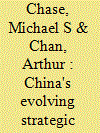

|
|
|
|
|
| Summary/Abstract |
Strategists often think of strategic deterrence as synonymous with nuclear deterrence, the top of the escalation ladder; China does not. In fact, China's strategic deterrence concepts are evolving and expanding, along with strides in strategic weapons capabilities, reflecting Beijing's increasing concerns about external security threats and a growing emphasis on protecting Chinese interests in space and cyberspace.
|
|
|
|
|
|
|
|
|
|
|
|
|
|
|
|
| 2 |
ID:
145758


|
|
|
|
|
| Summary/Abstract |
For the United States and other Western governments, the root of the problem is that the potential for non-state actors to execute propaganda campaigns of this scale and effectiveness is new to geopolitics. The information front against terrorist organizations is now of vital strategic significance, and the U.S. government was initially caught unprepared. Foreign policy leaders will not be effective in the 21st century, however, if they do not understand how the nuanced use of media is fundamental to the formation of our foreign policy, and not just in explicating and justifying policies.
|
|
|
|
|
|
|
|
|
|
|
|
|
|
|
|
| 3 |
ID:
145761
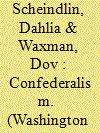

|
|
|
|
|
| Summary/Abstract |
After years of wishful thinking and failed efforts at Israeli–Palestinian peacemaking, the Obama administration has now finally acknowledged what most observers have been saying for some time—there is no chance of a two-state solution to the conflict, at least in the next couple of years.1 Many now question whether such a solution will ever be possible. Although diplomats and experts have long regarded a two-state solution as the best way to resolve this most intractable conflict—and for the last two decades, a majority of Israelis and Palestinians have agreed with this—this conventional wisdom is now seriously in doubt.
|
|
|
|
|
|
|
|
|
|
|
|
|
|
|
|
| 4 |
ID:
145760
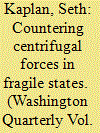

|
|
|
|
|
| Summary/Abstract |
International efforts to build strong states in places which lack them have repeatedly failed.1 Although some have taken failures in places such as Afghanistan, Iraq, and Somalia as reason for retrenchment, the violent movements that have sprung from the porous borders of the fragile world have illustrated that ignoring fragile states comes with a tremendous cost.
|
|
|
|
|
|
|
|
|
|
|
|
|
|
|
|
| 5 |
ID:
145765
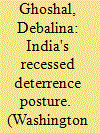

|
|
|
|
|
| Summary/Abstract |
As Pakistan continues to increase its fissile material stockpile, potentially soon surpassing France’s and Britain's,1 and as China is also modernizing its nuclear force, India's nuclear deterrence posture needs to be discussed. India is moving toward a ‘credible minimum deterrent posture,’ with nuclear-capable ballistic missiles and aircraft now a reality. India's no-first-use doctrine coupled with a recessed deterrence posture has enabled New Delhi to strengthen strategic stability in the South Asian periphery by ensuring a high nuclear threshold.
|
|
|
|
|
|
|
|
|
|
|
|
|
|
|
|
| 6 |
ID:
145759
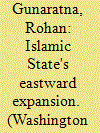

|
|
|
|
|
| Summary/Abstract |
The terrorist attack in Jakarta on January 14, 2016, that killed eight people is just the beginning—part of the Islamic State's (IS) strategy to create chaos and expand into Southeast Asia, complementing its goal of global expansion. Although the arrests in the lead-up to Christmas—including the arrest of Arif Hidayatullah (alias Abu Muzab) and his cell in December 2015—and the prompt response to the attack by the Jakarta Police Chief, General Dr. Tito Karnavian, prevented a “concert” the terrorists had vowed to conduct, the threat has not diminished.1 In fact, the global expansion of IS will be marked by its declaration of far-flung wilayāt (sometimes written as wilayat, wilāyah or wilayah), also known as governorates, presenting an emerging challenge for both national and regional governments. IS declared 34 wilayah in eleven countries after pledges of support from local groups and individuals who take their oath of allegiance to Abu Bakr al-Baghdadi, the self-appointed Caliph, or leader, of IS. Coalition resources are already overstretched and partners are overwhelmed. From Africa to the Middle East and the Caucasus to the Afghanistan–Pakistan border, IS is claiming authority and mobilizing support to defend the “caliphate” in its formative phase, expanding from the Middle East to a global theater of operations.
|
|
|
|
|
|
|
|
|
|
|
|
|
|
|
|
| 7 |
ID:
145762


|
|
|
|
|
| Summary/Abstract |
After months of contentious debate, Japan's parliament, called the Diet, in mid-September 2015 finally passed the Shinzo Abe government's package of eleven bills on security.1 This legislation, along with the revised U.S.–Japan Defense Cooperation Guidelines of April 2015, will transform the legal and institutional framework for Japanese defense policy and U.S.–Japan security relations.2 Japanese proponents of this transformation have argued the changes are necessary to make bilateral security cooperation more seamless to respond effectively to new regional and global security challenges and to contribute more proactively to international security affairs. Opponents, however, have charged that the legislation illegitimately hollows out Article 9 of Japan's constitution—which outlaws war as a means to settle international disputes—and could embroil Japan in misguided wars launched by the United States.3 Chinese and Korean critics of the legislation have echoed these criticisms by claiming that Japan is now remilitarizing.
|
|
|
|
|
|
|
|
|
|
|
|
|
|
|
|
| 8 |
ID:
145766
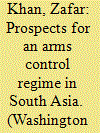

|
|
|
|
|
| Summary/Abstract |
There have been several confidence-building measures (CBMs) between India and Pakistan in both the pre- and post-nuclear periods. There was even a proposal to create a strategic restraint regime, whereby both India and Pakistan could eventually create institutions that could avoid the crises triggering conventional and nuclear conflict. However, these CBMs have failed to produce promising results because of enduring interstate rivalry between the two countries, and have played little or no role in sustaining peace and strategic stability in South Asia. The Kargil conflict of 1999, the common border confrontation in 2001–2002 on the Line of Control, and the Mumbai terror attack in 2008 (attributed to a Pakistani group) all highlight the enduring standoff between the two states.
|
|
|
|
|
|
|
|
|
|
|
|
|
|
|
|
| 9 |
ID:
145764


|
|
|
|
|
| Summary/Abstract |
Like other powers, over the last two decades India has reevaluated its military strategy, tactics, and doctrine. The doctrinal reassessment is regional-centric,1 seemingly planned to gain regional influence with the intention of acquiring a great power status. The structural changes in the overall Indian military strategy involve its nuclear doctrine, which is quite worrisome for Islamabad. Particularly disconcerting, Indian doctrinal restructuring, although like any other modern state, is shrouded in ambiguity. This is likely to intensify the “fog of war,”2 and would unfortunately create more uncertainty, especially during crises or conflicts.
|
|
|
|
|
|
|
|
|
|
|
|
|
|
|
|
| 10 |
ID:
145757
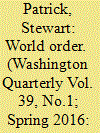

|
|
|
|
|
| Summary/Abstract |
The international rules-based order established after World War II seems to be under relentless pressure, threatening its foundations existentially. If so, what if anything can be done to reinvigorate it? This question raises several others a priori: First, what are the most distinctive attributes of the post-1945 world order; how did that order come into being; and what explains its longevity? Second, what forces are now placing this order under strain? Third, what aspects of today's order are most vulnerable—and which are most resilient? Fourth, what principles, frameworks, and objectives should guide U.S. policy toward world order going forward? This essay seeks to answer those fundamental questions in an effort to strengthen the foundation of global stability and order.
|
|
|
|
|
|
|
|
|
|
|
|
|
|
|
|
|
|
|
|
|